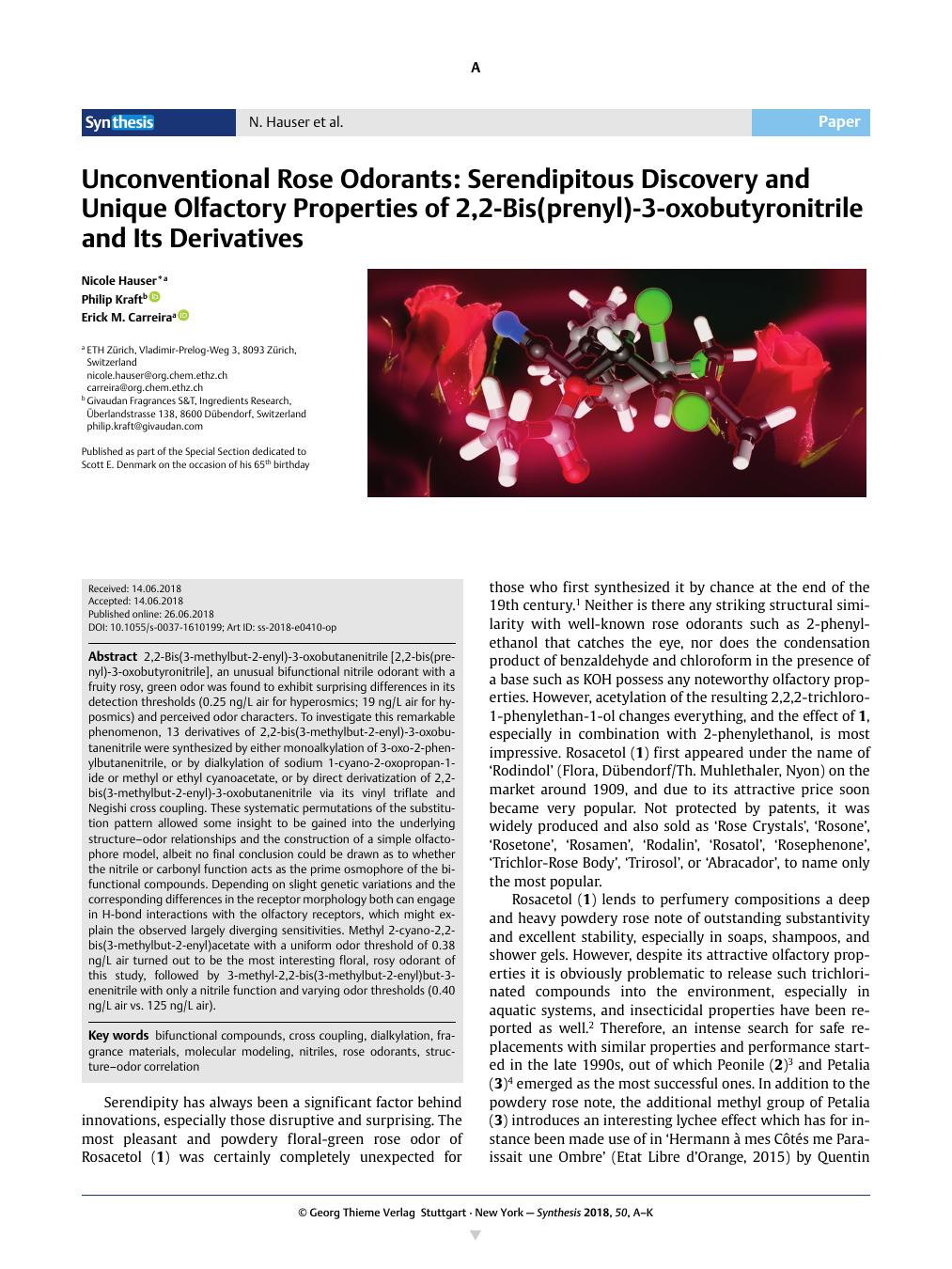Synthesis ( IF 2.6 ) Pub Date : 2018-06-26 , DOI: 10.1055/s-0037-1610199 Nicole Hauser 1 , Philip Kraft 2 , Erick Carreira 1

|
Published as part of the Special Section dedicated to Scott E. Denmark on the occasion of his 65th birthday
Abstract
2,2-Bis(3-methylbut-2-enyl)-3-oxobutanenitrile [2,2-bis(prenyl)-3-oxobutyronitrile], an unusual bifunctional nitrile odorant with a fruity rosy, green odor was found to exhibit surprising differences in its detection thresholds (0.25 ng/L air for hyperosmics; 19 ng/L air for hyposmics) and perceived odor characters. To investigate this remarkable phenomenon, 13 derivatives of 2,2-bis(3-methylbut-2-enyl)-3-oxobutanenitrile were synthesized by either monoalkylation of 3-oxo-2-phenylbutanenitrile, or by dialkylation of sodium 1-cyano-2-oxopropan-1-ide or methyl or ethyl cyanoacetate, or by direct derivatization of 2,2-bis(3-methylbut-2-enyl)-3-oxobutanenitrile via its vinyl triflate and Negishi cross coupling. These systematic permutations of the substitution pattern allowed some insight to be gained into the underlying structure–odor relationships and the construction of a simple olfactophore model, albeit no final conclusion could be drawn as to whether the nitrile or carbonyl function acts as the prime osmophore of the bifunctional compounds. Depending on slight genetic variations and the corresponding differences in the receptor morphology both can engage in H-bond interactions with the olfactory receptors, which might explain the observed largely diverging sensitivities. Methyl 2-cyano-2,2-bis(3-methylbut-2-enyl)acetate with a uniform odor threshold of 0.38 ng/L air turned out to be the most interesting floral, rosy odorant of this study, followed by 3-methyl-2,2-bis(3-methylbut-2-enyl)but-3-enenitrile with only a nitrile function and varying odor thresholds (0.40 ng/L air vs. 125 ng/L air).
2,2-Bis(3-methylbut-2-enyl)-3-oxobutanenitrile [2,2-bis(prenyl)-3-oxobutyronitrile], an unusual bifunctional nitrile odorant with a fruity rosy, green odor was found to exhibit surprising differences in its detection thresholds (0.25 ng/L air for hyperosmics; 19 ng/L air for hyposmics) and perceived odor characters. To investigate this remarkable phenomenon, 13 derivatives of 2,2-bis(3-methylbut-2-enyl)-3-oxobutanenitrile were synthesized by either monoalkylation of 3-oxo-2-phenylbutanenitrile, or by dialkylation of sodium 1-cyano-2-oxopropan-1-ide or methyl or ethyl cyanoacetate, or by direct derivatization of 2,2-bis(3-methylbut-2-enyl)-3-oxobutanenitrile via its vinyl triflate and Negishi cross coupling. These systematic permutations of the substitution pattern allowed some insight to be gained into the underlying structure–odor relationships and the construction of a simple olfactophore model, albeit no final conclusion could be drawn as to whether the nitrile or carbonyl function acts as the prime osmophore of the bifunctional compounds. Depending on slight genetic variations and the corresponding differences in the receptor morphology both can engage in H-bond interactions with the olfactory receptors, which might explain the observed largely diverging sensitivities. Methyl 2-cyano-2,2-bis(3-methylbut-2-enyl)acetate with a uniform odor threshold of 0.38 ng/L air turned out to be the most interesting floral, rosy odorant of this study, followed by 3-methyl-2,2-bis(3-methylbut-2-enyl)but-3-enenitrile with only a nitrile function and varying odor thresholds (0.40 ng/L air vs. 125 ng/L air).
中文翻译:

非常规玫瑰气味:2,2-双(异戊烯基)-3-氧代丁腈及其衍生物的偶然发现和独特的嗅觉特性
发布时间为致力于斯科特E.丹麦在他65之际特殊部分的部分次生日
抽象的
2,2-双(3-甲基丁-2-烯基)-3-氧代丁腈[2,2-双(异戊烯基)-3-氧代丁腈],一种不寻常的双功能丁腈香精,具有果味的玫瑰色,绿色气味,令人惊讶检测阈值的差异(高渗空气的浓度为0.25 ng / L空气;低渗空气的浓度为19 ng / L空气)和嗅觉特征。为了研究这种显着现象,通过3-氧代-2-苯基丁腈的单烷基化或1-氰基-钠的二烷基化合成了2,2-双(3-甲基丁-2-烯基)-3-氧代丁腈的13种衍生物。 2-氧丙烷-1-化物或氰基乙酸甲酯或乙酯,或通过2,2-双(3-甲基丁-2-烯基)-3-氧代丁腈经其三氟甲磺酸乙烯酯和Negishi交叉偶联直接衍生而来。取代模式的这些系统排列使我们对潜在的结构-气味关系和简单的嗅觉发光体模型的构建有了一定的了解,尽管无法得出关于腈或羰基功能是否是该化合物的主要渗透体的最终结论。双功能化合物。取决于轻微的遗传变异和受体形态的相应差异,两者均可参与与嗅觉受体的H键相互作用,这可能解释了观察到的敏感性差异很大。空气中气味阈值统一为0.38 ng / L的2-氰基2,2-双(3-甲基丁-2-烯基)乙酸甲酯被证明是该研究中最有趣的花香,玫瑰色香精,其次是3-甲基-2
2,2-双(3-甲基丁-2-烯基)-3-氧代丁腈[2,2-双(异戊烯基)-3-氧代丁腈],一种不寻常的双功能丁腈香精,具有果味的玫瑰色,绿色气味,令人惊讶检测阈值的差异(高渗空气的浓度为0.25 ng / L空气;低渗空气的浓度为19 ng / L空气)和嗅觉特征。为了研究这种显着现象,通过3-氧代-2-苯基丁腈的单烷基化或1-氰基-钠的二烷基化合成了2,2-双(3-甲基丁-2-烯基)-3-氧代丁腈的13种衍生物。 2-氧丙烷-1-化物或氰基乙酸甲酯或乙酯,或通过2,2-双(3-甲基丁-2-烯基)-3-氧代丁腈经其三氟甲磺酸乙烯酯和Negishi交叉偶联直接衍生而来。取代模式的这些系统排列使我们对潜在的结构-气味关系和简单的嗅觉发光体模型的构建有了一定的了解,尽管无法得出关于腈或羰基功能是否是该化合物的主要渗透体的最终结论。双功能化合物。取决于轻微的遗传变异和受体形态的相应差异,两者均可参与与嗅觉受体的H键相互作用,这可能解释了观察到的敏感性差异很大。空气中气味阈值统一为0.38 ng / L的2-氰基2,2-双(3-甲基丁-2-烯基)乙酸甲酯被证明是该研究中最有趣的花香,玫瑰色香精,其次是3-甲基-2



























 京公网安备 11010802027423号
京公网安备 11010802027423号